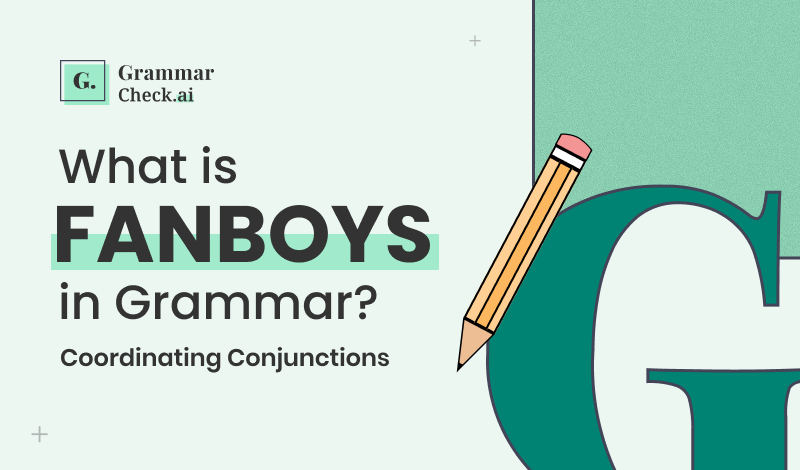
FANBOYS is the acronym of “For”, “And”, “Nor”, “But”, “Or”, “Yet”, and “So” which are seven most commonly used coordinating conjunctions.
If you're writing an essay or research paper or just want to avoid stumbling over words, you need to learn FANBOYS in grammar.
This blog will only focus on the basics of FANBOYS, their use cases, and how they improve your writing.
Coordinating conjunction connect two or more parts of a sentence that are at same grammatical level.
When coordinators join two different clauses together, they don't make one part depend on the other. Rather, they make both parts whole thoughts.
Each letter of FANBOYS serves a unique purpose. In this section, we will be explaining those purposes in complete detail.
The conjunction “For” is widely used to explain the reason or justification for the preceding clause. In informal writing/content, it is often replaced with “Because,” but still, “For” is definitely the more direct and formal word.
Example:
“He didn’t go to work, for he was feeling unwell.”
“And” is a popular coordinating conjunction that is used to connect multiple ideas, no matter if they are words, phrases, or full clauses.
Example:
“Alice bought apples and oranges.”
After writing a negative statement or sentence, “Nor” is used to add additional negative ideas.
Example:
“He doesn’t like the tea, nor does he drink coffee.”
The “B” in FANBOYS refers to “But,” which is used to introduce a contrast between two ideas within a sentence; here is an example.
Example:
“My parents are strict, but fair.”
The “Or” conjunction is used to introduce options or alternatives in a sentence. In some contexts, it can also be used to express consequences.
Example:
“Would you like a coffee or a tea?”
The “Yet” serves a similar function, but it is usually used to emphasize an unexpected coordination/surprise.
Example:
“He is wealthy, yet lives modestly.”
The “So,” connects a cause with its result or consequence, and that’s why it is considered useful for showcasing what happens as a result of something else.
Example:
“Aline missed the tram, so he walked to reach the destination.”
Below, we’ve compiled some use cases of the FANBOYS grammar that can help you improve your writing.
Single words are available in numerous types, including verbs, nouns, and many more. With the FANBOYS, you can join single words with their respective counterparts.
Example:
“The boy was tall and handsome.”
In this example, the word ‘and joins the adjectives ‘tall’ and ‘handsome’ to provide a concrete vision to the reader about the boy’s appearance.
Example:
“I was shivering yet slid down the freezing slope of ice.”
Here, the word yet joins two verbs together, showing a contrast of emotions in how the narrator felt when coming down the slope.
Phrases can be of many types, and each one of them can be joined together to create an impact or maintain a chain of thoughts.
The following line represents the FANBOYS word nor joining two verb phrases, telling how the person ignored the narrator.
Example:
“John didn’t reply to my texts nor pick up my calls.”
Independent clauses can sustain themselves as standalone sentences. They have a subject, verb and an object. These are often joined together with FANBOYS and a comma to present a compound sentence.
Example:
“Esha skipped office today, for she didn’t feel well.”
The word joins two complete ideas together with a comma , explaining Esha’s situation completely. It can be used in place of "because," as highlighted by Hancock College in there document.
Commas with coordinating conjunctions often appear in two circumstances. First, when two independent clauses are joined together. And second, when they stitch two or more elements in a series.
Tip: You need to check punctuation mistakes to use FANBOYS correctly while joining independent clauses.
As we have previously highlighted throughout this post, utilizing FANBOYS can provide a lot of benefits to your writing. These are listed below in detail.
FANBOYS are crucial to answering the question, “What happened, and how?”
Take a look at the previous example where we joined two prepositional phrases. The reader can understand that Venn was the first one to go to the parking lot, followed by the narrator and then Rex.
The FANBOYS conjunctions help to list things quickly and smoothly; check the example below for more clarity.
Example:
“We can eat a burger, a sandwich, or pizza for lunch.”
As is evident, the nouns are joined by one of our FANBOYS, or. Hence, making it easy for the reader to go through the list without getting confused or lost.
We use FANBOYS consciously and subconsciously in our daily writing routines. This makes your writing more logical, that is easy to follow for the reader.
Reader-appealing crafts use coordinating, subordinating, and correlative conjunctions and conjunctive adverbs.
There is no doubt that “For”, “And”, “Nor”, “But”, “Or”, “Yet”, and “So” are just small words, but they play a essential role in English grammar. Each letter of FANBOYS acronym helps you craft a coherent, well-structured, and balance your writing. In this blog post, we have tried our best to discuss every possible detail that you need to know about FANBOYS conjunctions.
Recent Blogs